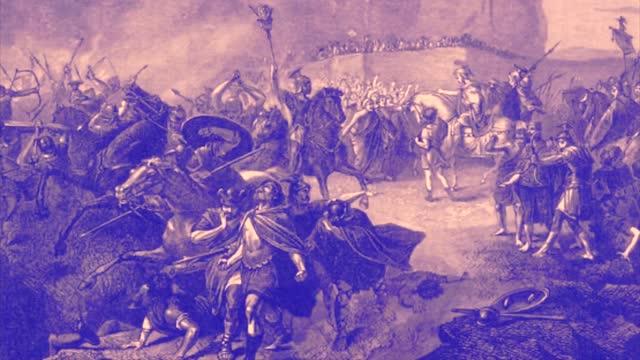Premium Only Content

AD GLORIAM ROMANORVM FLAVIVS BELISARIVS VENIT PER PORTAM ASINARIAM ROMAM INTRAT (9 DEC. 536 A.D.)
AD GLORIAM ROMANORVM FLAVIVS BELISARIVS VENIT PER PORTAM ASINARIAM ROMAM INTRAT (9 DEC. 536 A.D.)
http://zazzle.com/ProVaticanus
He entered the city through the Porta Asinaria, a gate on the Aurelian Wall, built by the third century emperor who restored a splintered empire. Belisarius and his small army were reconquering the city of Rome for the Roman Emperor Justinian, based in Constantinople. The city had not had a Roman Emperor in sixty years. It was December 9, 536 AD.
In the 2nd and 3rd centuries Rome was the largest city in the world with a population estimated at one million. Even with the slow decline and eventual end of the western Roman Empire, the city remained prosperous (at least relative to much of the rest of the West) into the early 6th century with perhaps 200,000 inhabitants as late as 500 AD.
Yet a decade after Belisarius' entry Rome went through a brief period when it was virtually depopulated and a decade after that the population was still no more than 30,000. Indeed, for a thousand years, Rome's population did not exceed 50 or 60,000 (except for brief periods when refugees from various wars crammed inside its walls) and did not again reach a million inhabitants until the 1930s. What happened?
At the beginning of the fourth century Rome covered about 3,400 acres within the Aurelian Walls, and its total urbanized area may have been 6,000 acres. The city contained 28 libraries, 1,352 street fountains, and 856 communal baths with a capacity of 63,000. To supply the city with 200,000 tons of grain annually and other vital supplies, seventeen ships arrived each day during the sailing season at the city's ports at Ostia. More than 300,000 amphorae containing olive oil arrived each year which, when empty, were discarded into a huge landfill that still exists today containing the rubble of an estimated 53 million amphorae rising 30 meters high and a kilometer in circumference. (Statistics from Rome: A Living Portrait Of An Ancient City, Stephen L Dyson (2010)).
And what would a visitor see in the heart of the city?
The great streets . . . all ended in the same general area, marked by the Capitoline Hill, Forum, Palatine, and Colosseum. Over the centuries this area had grown into a grand display of state architecture . . . There, Romans, provincials, and foreigners gawked at temples, basilicas, theatres, porticos; heaps of marbles . . . gilded capitals, triumphal arches, honorific statues . . . all this was the grand show that reflected the glory of Rome and her empire (Rome: Profile of a City, 312-1308, Richard Krautheimer
N.B., 'Entry of Belisarius into Rome', (536 AD), 1890. Flavius Belisarius (c500-565) a general of the Roman Empire, during the Gothic War entered Rome unopposed in late spring 536 AD. From "Cassell's Illustrated Universal History, Vol. III - The Middle Ages", by Edmund Ollier. [Cassell and Company, Limited, London, Paris and Melbourne, 1890. ]
#Gloria #Belisarius #Rome
Ago tibi gratias Deo per instrumenta de Paulo Lacayo pro bono rei publicae.
-
 53:08
53:08
ProVaticanus
29 days agoMISSA PAPÆ MARCELLI
281 -
 LIVE
LIVE
Sarah Westall
19 minutes agoTapping into the Human BioField and how its Reshaping our Understanding of Life w/ Eileen McKusick
82 watching -
 8:35
8:35
Melonie Mac
3 hours agoNew Predator Badlands Trailer Just Dropped
6604 -
 UPCOMING
UPCOMING
freecastle
50 minutes agoTAKE UP YOUR CROSS- YES, Americans Want Safety and Secure Borders!
43 -
 2:06
2:06
Gamazda
1 hour ago $0.72 earnedBlack Sabbath - Paranoid (Piano)
7.64K16 -
 1:12:24
1:12:24
vivafrei
3 hours agoPam Bondi CORRECTS COURSE! Ghislaine Maxwell Will TALK? Special Guest Dr. Joel Warsh & MORE!
93.1K24 -
 1:19:13
1:19:13
Awaken With JP
3 hours agoObama Incrimination, Epstein Hoax, and Plenty of Nonsense - LIES Ep 101
27.2K22 -
 1:55:52
1:55:52
The Quartering
3 hours agoToday's Breaking News!
85.1K11 -
 1:00:04
1:00:04
Russell Brand
5 hours agoDr. Oz and the War for Your Health - SF618
149K31 -
 LIVE
LIVE
Viss
4 hours ago🔴LIVE - Your Helping Hand to Winning In PUBG!
219 watching